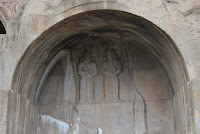(...)
After having lunch and a relaxing period we set off to explore the Taq-e Bostan again, once the previous later afternoon visit hadn't allowed me to thoroughly look at the carvings in the "grottoes". I was really looking forward to this second visit, which officials at the entrance gently allowed us to do without having to pay the entrance fee again.

Legend has it that this used to be an enormous reception area where the Sassanid rulers received envoys from the Chinese and Roman empires in great splendour in the past. The first carved column showed a Sassanid King holding the diadem (Ring of Authority). The exact function of these two man made caves is said to be undetermined, though the hunting scenes depicted on the two side walls suggest it used to be a Sassanid Royal hunting park. A stylised Tree of Life, eventually symbolising the Zoroastrian Tree of All Seeds, from which all known plants are believed to have germinated, is carved on either side of the main grotto with beautifully carved Rubensesque victory angels above.
At the back of the cave a free-standing figure of a rider and horse has been carved from the rock, while above stand The Zoroastrian Goddess Anahita pouring a libation, a kingly figure in the centre and Ahura Mazda (from left to right).There is some doubt as to which Sassanid King is depicted, though the particular type of crown seems to suggest it is Peroz (457-84 CE) it is most likely Khosrou II (590-628 CE9 riding on his legendary horse Shabdiz. High up on the far left is a low relief of Mohammed Ali Mirza, son of Fath Ali Shah, recording his governorship of the region (dating from 1822).
The next grotto depicts the figure of Shapur III (383-8 CE) with his grandfather Shapur II. A little further along there is a low relief of the investiture of Ardashir II (379-83 CE) with Ahura Mazda on the right, while Mithra, the Zoroastrian "Lord of Contract and Justice" stands on a lotus dais, carrying a barsom of twigs for the sacred fire. Under the feet of Ardashir II lies a defeated enemy, believed to be a Roman emperor (it has been suggested it could be Julian the Apostate because of the beard).












There were quite a few local visitors, which no longer surprised me, once I had become accustomed to the idea that Iranians do love and acknowledge their heritage by visiting historic places very often (as often as they may). I just wished we had a similar type of attitude in regards to our history.



(To be continued)




















No comments:
Post a Comment